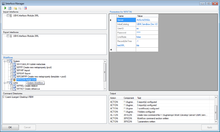Interface Manager
The Interface Manager is meant for administration and testing of interfaces from or to UBIK®, before deploying them to the EnterpriseService.
When started, the interface manager searches for valid UBIK® interface components, where an interface component can be either an assembly or a Workflow.
Interface Assemblies
Interface assemblies are very useful when the need for complex interfacing arises. Since they are programmed in .NET or any compatible language, almost everything is possible here.
Identification
- UBIK® tries to find a sub-directory Interfaces parallel to the UBIK.Studio.exe and scan it for assemblies (*.dll) which name matches the pattern UBIK.Interface.*
- it looks for types (classes) in those assemblies which derive from UBIK.Interface.UBIKInterfaceBase
- it checks if those types implement either UBIK.Interface.IUBIKImport or UBIK.Interface.IUBIKExport or both
All components that fulfill those criteria will be listed in the boxes Import Interfaces and/or Export Interfaces. Checking a component will mark it generally for execution with the UBIK® EnterpriseService, if a respective valid .command file lands in one of the folders that can be added to Command Directories.
Workflows
Workflows provide a more user friendly way of interfacing to other systems. Besides the visual design capabilities, they also offer a wide range of predefined activities for standard tasks, as well as powerful tracing- and debugging functionality.
Parameters
The Parameters table allows the creation of named parameters that are passed via the .command file, to enable conditional execution.
Toolbar
A valid .command file for a component can be created with the button Create command file at any time, it will also be stored in the Interfaces sub-folder and named accordingly. Use this generated file to call your interface via the EnterpriseService later.

